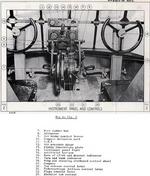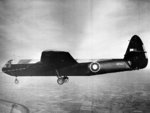Horsa
| Country | United Kingdom |
| Manufacturer | Airspeed Limited |
| Primary Role | Glider |
| Maiden Flight | 21 September 1941 |
Contributor: David Stubblebine
ww2dbaseThe Airspeed AS.51 Mk I and AS.58 Mk II Horsa gliders were British World War II troop-carrying gliders built by Airspeed Limited and subcontractors and used for air assault by British and Allied armed forces. The Mk I and the Mk II were virtually identical in outward appearance and performance but, naturally, some design improvements were seen in the Mk II. They were named after Horsa, the legendary 5th century conqueror of Southern Britain.
ww2dbaseDesign and Development
ww2dbaseThe Horsa first flew on 12 September 1941. It was a high-wing cantilever monoplane with wooden wings and a wooden semi-monocoque fuselage. The fuselage was built in three sections and bolted together. The front section was the pilot's compartment and main freight loading door, the main section was accommodation for troops or freight, and the rear section supported the tail unit. It had a fixed tricycle landing gear and it was one of the first gliders equipped with a tricycle undercarriage for take off. On operational flights this could be jettisoned and landing was then on a sprung skid under the fuselage. The wing carried large "barn door" flaps which, when lowered, made a steep, high rate-of-descent landing possible - allowing the pilots to land in constricted spaces. The pilot's compartment had two side-by-side seats and dual controls. Aft of the pilot's compartment was the freight loading door on the port side. The hinged door could also be used as a loading ramp. The main compartment could accommodate 15 troops on benches along the sides with another access door on the starboard side. Supply containers could also be fitted under the centre-section of the wing, three on each side. The later AS.58 Horsa II had a hinged nose section, reinforced floor and double nose wheels to support the extra weight of vehicles. The tow was attached to the nose-wheel strut, rather than the dual wing points of the Horsa I.
ww2dbaseTo assist in rapid unloading of troops and equipment on landing, the fuselage joint to the rear of the Horsa's main section could be broken after landing, releasing the empennage (tail section). After the Normandy invasion, explosive bolts were installed to make this process even more rapid. On at least one occasion (Market Garden, Sept 1944), the bolts exploded in flight as the craft was being towed to the target area with a full load of combat troops aboard. The empennage was released and fell away, destroying all capabilities for independent flight. While the Horsa continued to trail behind its tug, it is not known what became of this glider after it released its tow line.
ww2dbaseThe Horsa was considered sturdy and very maneuverable for a glider. Production was by Airspeed and subcontractors including Austin Motors and the furniture manufacturer Harris Lebus. A total of 3655 were built. The specification for the gliders had demanded that they were built in a number of sections, and to use facilities not needed for more urgent production, and as a result production was spread across separate factories which limited the likely loss in case of German attack.
ww2dbaseOperational History
ww2dbaseThe use of assault gliders by the British was prompted by the use by Germany of the DFS 230, which was first used in May 1940 to successfully assault the Eben Emael fort in Belgium. Their advantage compared to parachute assault was that the troops were landed together in one place, rather than being dispersed.
ww2dbaseWith around 28 troop seats, the Horsa was much bigger than the 13-troop US Waco CG-4A Haig (known as the Hadrian by the British), and the 8-troop General Aircraft Hotspur glider which was intended for training duties only. As well as troops, the AS.51 could carry a jeep or a 6 pounder anti tank gun.
ww2dbaseThe Horsa was first used operationally on the night of 19/20 November 1942 in the unsuccessful attack on the German Heavy Water Plant at Rjukan in Norway (Operation Freshman). The two Horsa gliders, and one of the Halifax tug aircraft, crashed in Norway due to bad weather. All 23 survivors from the glider crashes were executed on the orders of Hitler, in direct breach of the Geneva Convention which protects POWs from summary execution. After this Hitler called the airborne soldiers "Red Devils" due to their maroon berets. The name stuck with them.
ww2dbaseOn 10 July 1943, 27 Horsas were used in Operation Husky, the invasion of Sicily. Large numbers were subsequently used in Operation Tonga and the American airborne landings in Normandy, Operation Dragoon (southern France), Operation Market Garden (Arnhem) and Operation Varsity (crossing the river Rhine). In Normandy, the first units to land in France did so by Horsas, capturing Pegasus Bridge over the Caen Canal.
ww2dbaseOn operations they were towed variously by Stirling, Halifax, Albemarle, Whitley and Dakota tugs. The pilots were usually from the Glider Pilot Regiment, part of the Army Air Corps, although Royal Air Force pilots were used on occasion. The Horsa was also used in service by the US Airborne operations.
ww2dbaseOn 5 June 2004, as part of the 60th anniversary commemoration of D-Day, Prince Charles unveiled a replica Horsa on the site of the first landing at Pegasus Bridge in Benouville, France, and talked with the original pilot of the aircraft, Jim Wallwork.
ww2dbaseVariants
ww2dbaseAS.51 Horsa I
Production glider with cable attachment points at upper attachment points of main landing gear.
ww2dbaseAS.58 Horsa II
Development of the Horsa I with hinged nose, to allow direct loading and unloading of equipment, twin nose-wheel and cable attachment on nose-wheel strut.
ww2dbaseSources: 315th Troop Carrier Group Association, Fiddlers Green, Royal Air Force, Wikipedia, WWII Glider Pilots Association .
Last Major Revision: Dec 2008
SPECIFICATIONS
Mk I
| Armament | Can carry 25 glider troops or 1 field gun |
| Crew | 2 |
| Span | 26.83 m |
| Length | 20.43 m |
| Height | 5.95 m |
| Wing Area | 102.60 m² |
| Weight, Empty | 3,804 kg |
| Weight, Loaded | 7,045 kg |
| Speed, Maximum | 242 km/h |
| Speed, Cruising | 160 km/h |
Photographs
 |  |
Please consider supporting us on Patreon. Even $1 per month will go a long way! Thank you. Please help us spread the word: Stay updated with WW2DB: |
Visitor Submitted Comments
30 Sep 2010 01:46:36 AM
Further to RTB's comments above: The Horsa was delivered in 30 seperate parts which then had to be assembled (usually by RAF Maintenance Units). Only about 700 of the 3,799 machines built came fully assembled from the Airspeed factory at Christchuch, Hants.
17 Mar 2013 01:58:41 PM
I have a print of a Horsa, landed, with parachute Regt loading their bren guns carrier. The chalk number is 261,the fuselage number is R 4027, presumably the first letter is missing and the name is 'The Undertaker'
12 Jul 2014 10:42:44 AM
I am in contact with a 94 year-old American Glider pilot who flew Horsas only, and landed on D-Day minus, and also in Nancy and Saargemund. I can find no information on the latter two operations. He had a DUKW on board in the last operation where the glider was shot down and crashed in the trees after having been hit at 5,000 feet with an German 88 mm anti-aircraft shell.
22 Nov 2014 10:02:50 PM
I am looking for an American Horsa Pilot for a project I'm working on. Could you please put me in contact with the gentleman you spoke of or given him my contact information. Thank you.
Lance Burrell, Payson, UT. 801-494-9451
27 Feb 2016 08:45:12 AM
My father was US Army 13th Airborne WW2. He flew in Waco's and Horsa Gliders. He was trained with 50 cal. Heavy Water Cooled Machine gun, M1 Rifle and 57mm field artillery. He claimed he preferred the British Glider to the American Waco. He served in France during the war and was activated for operations which did not occur due to our fast moving armies.
1 Mar 2016 01:33:33 PM
Great site. I am looking for details when Horsa gliders were first sent for storage at RAF Downham Market, Norfolk in 1943. Would like to find out date, and details please. Thank you.
3 Jan 2017 06:23:52 PM
A new memorial commemorating "Operation Deadstick" the taking of Pegasus Bridge. The Pegasus Bridge Memorial Flight is being established in the Allied Special Forces Memorial Grove at the National Memorial Arboretum. UK
25 Nov 2017 10:27:14 AM
Hello, I am looking to build a replica model of the Horsa and I have had no luck finding any detailed plans. Can anyone help please?
7 Jan 2023 03:41:53 AM
Can somebody tell me the names of the pilots on d day horsa gliders at pegasus bridge ?
Thanks
26 May 2023 08:13:07 AM
Does anyone have photographs of Horsa's LJ309 and/or RN771, either in service or as fuselages dumped near the railway statio near Albrighton, Staffordshire? They were still there as late as May 1975
All visitor submitted comments are opinions of those making the submissions and do not reflect views of WW2DB.

- » US State Lawmaker John Winter Caught Using Racial Slur "Jap" and Apologized (11 Jun 2025)
- » Köln/Cologne Evacuated After Discovery of WW2 Bombs (4 Jun 2025)
- » US Women's Army Corps "Six Triple Eight" Awarded with Congressional Gold Medal (30 Apr 2025)
- » Race, Holocaust, and African-American WW2 Histories Removed from the US Naval Academy Library (7 Apr 2025)
- » US Government Plans to Purge WW2 Information (17 Mar 2025)
- » See all news
- » 1,176 biographies
- » 337 events
- » 44,933 timeline entries
- » 1,245 ships
- » 350 aircraft models
- » 207 vehicle models
- » 376 weapon models
- » 123 historical documents
- » 261 facilities
- » 470 book reviews
- » 28,471 photos
- » 365 maps
Chiang Kaishek, 31 Jul 1937
15 Sep 2009 05:15:14 PM
Born 1928 in Thatcham 2 miles fro Greenham Common. Saw Waco Gliders, brought in wooden boxes from the US some on spar daecks of tankers to Liverpool,being assembeled by GIs spoke to them Saw C - 47 towing them. More in my memoirs A sailor on Horseback or a Rolling Stone Memoirs of Capt. Robert T. Bush
available on amazon.com